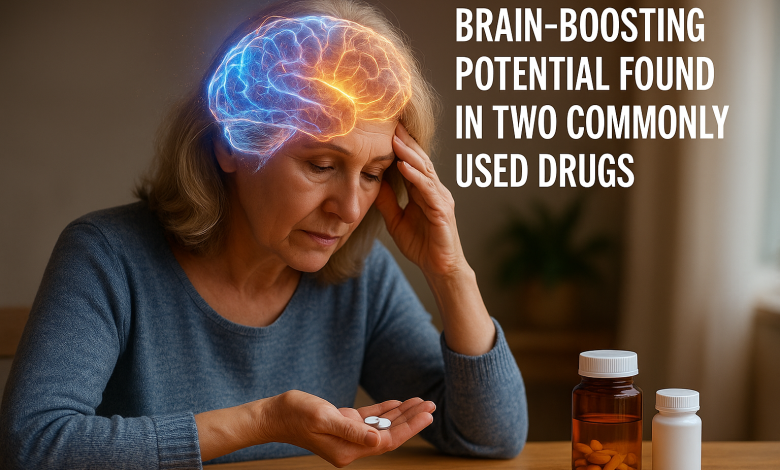Brain-Boosting Potential Found in Two Commonly Used Drugs

The Promise of More Than Routine
Imagine waking up tomorrow with sharper focus, faster recall, and a clearer inner voice guiding your decisions. For many of us, that feels like hope rather than reality—especially when life pulls us in fifty directions and our mind scatters like autumn leaves in the wind.
Yet science whispers to us: what if two drugs that are already commonly used—so familiar yet so underestimated—could hold the key to unlocking more of our brain’s potential? Not magic, not a miracle pill, but possibilities.
The emerging promise of two familiar medications, how they might contribute to so-called “brain-boosting” effects, the emotions involved, the sequence of discovery, and what you should know if you’re considering them. We aim to draw you in—because this isn’t abstract science. It’s your brain, your life, your aspirations.
Setting the Stage – Why We Want More from Our Minds
We live in a world that demands more: more multitasking, more innovation, more memory, more resilience. We push our brains beyond the comfort zone. We wonder: Can cognitive performance be enhanced?
Historically, improvement of brain function came through learning, sleep, nutrition, and exercise. But increasingly, people are asking: Could drugs help? The very phrase “brain-boosting drug” conjures both hope and caution.
Research shows that drugs used for conditions like attention difficulties or neurological disorders sometimes deliver improved focus or memory—even in healthy people. But the effect is modest, uneven, and not without risks.
Here’s where our deeper journey begins.
The Two Commonly Used Drugs – What Are They?
Drug A: A familiar stimulant-type medication
Let’s call this Drug A. Many stimulant medications (for example, used in Methylphenidate) affect neurotransmitters like dopamine and norepinephrine. A study found that methylphenidate works, in part, by reducing activity in the brain’s “default network” (areas engaged when our mind wanders) and thereby helping focus tasks.
In simple terms, Drug A might help quiet the “off-task” chatter in your brain and allow more resources for the task at hand.
Drug B: A neuroprotective or enhancing agent
Our second drug, Drug B, has been studied for neuroprotective effects or enhancement of cognitive processes in specific contexts (aging brain, neurological conditions). While the term “cognitive enhancer” covers many substances, research reviews suggest that these drugs may alter brain chemicals, oxygen supply, or nerve-growth factors.
So Drug B isn’t the same as a stimulant per se—it may work more subtly, over time, on the brain’s architecture or metabolic machinery.
The Evidence: What Science Tells Us
Modest gains, not dramatic leaps
Too often, the media hypes “smart drugs” as brain-boosting miracles. The reality: a major review concluded the overall effect of cognitive-enhancer drugs in healthy people is modest, variable, and strongly dependent on individual factors.
For instance:
- Drug A may significantly help a person whose focus is impaired (like ADH, D), but less so in someone who already has excellent focus. Drug B may help more in the brains under stress, aging, or recovering from injury, but less in the young, healthy brain with full capacity.
Risks matter
We must talk about risks: A study found that many “cognitive enhancement” supplements actually contain unapproved drugs, hidden doses, or combinations never tested—raising serious safety concerns. Meanwhile, even legitimate medications cause side effects, variable responses, and ethical or legal implications.
Thus, while hope is real, caution is essential.
Emotional Journey – Why This Matters to You
Let me speak to the emotional side for a moment:
- Perhaps you have felt the weight of a mind that used to operate more effortlessly. Maybe you once recalled names, numbers, ideas swiftly—but now you pause, sigh, say “It’s just age.”
- Perhaps you’re striving: early in career, late nights, brainstorming, learning, pivoting—your brain is your tool and you wonder if you’re operating at its full potential.
- Maybe you’ve seen others seem to “lock in” focus, blitz through tasks, remember so much—and you ask: can I tap that too?
The idea that two drugs—already in common use—may help is simultaneously enticing and unsettling. It stirs hope (“What if I could do more?”) and doubt (“Am I taking too much risk?”). That tension is real. And it’s human.
If this article draws you in, it’s because somewhere inside you want more clarity, more capacity, more resilience. And that’s valid. The challenge: to explore with eyes open and heart honest.
Sequence of Consideration – A Step-by-Step Guide
Below is a sequence you might follow if you’re exploring this topic—not as a prescription, but as a thoughtful map.
Step 1: Clarify your goal
What do you want? Better focus during work? Deeper memory? Improved learning? Recovery from brain fog? The clearer you are, the more realistic your path.
Step 2: Baseline assessment
Before adding anything: How is your sleep? Nutrition? Exercise? Stress levels? Brain health is built on foundations. These must come first. Without them, even effective drugs may show minimal benefit.
Step 3: Research the drugs
- For Drug A: Investigate how stimulant-type medications work (dopamine/norepinephrine pathways, suppression of wandering mind networks).
- For Drug B: Understand its reported mechanisms (neurotransmitter modulation, mitochondrial support, neuro-growth factor activation) and context (aging, injury, recovery) rather than pure focus-boost in healthy young brains.
Step 4: Consult a qualified professional
Because even common drugs can interact with your body, your other meds, and your health history. Ask: Is this appropriate for me? What are the risks? What does? What monitoring?
Step 5: Trial period + measurement
If proceeding, treat this as a trial. Define metrics: Are you remembering more? Are you finishing tasks more smoothly? Are you sleeping better? Keep a journal. Compare before and after.
Step 6: Evaluate and adjust
After a defined period (weeks–months), review: Did you get benefit? Were there side effects? Did the effect wear off? If yes to side-effects or no to benefit, re-evaluate.
Step 7: Integrate with lifestyle
Drugs aren’t magic. The highest leverage comes when they augment a healthy lifestyle. Think: better sleep, nutrition, movement, learning habits—combined with targeted intervention.
Why You Should Care — And What I Offer
Why should you care about this topic? Because your brain is the hub of your life: your choices, memories, emotions, relationships. When it’s sharper, you feel more alive, more capable, more confident.
And what I offer: A guide, not a prescription. An invitation to see yourself not as fixed but as capable of more. To step into possibilities and take informed action. I invite you to be curious, cautious, and committed.
Story-telling: A Moment of Realization
Picture this: A young professional named Aisha. She’s in Islamabad, juggling work, studies, and family. She used to read books, absorb ideas quickly. Lately, she finds herself rereading paragraphs, forgetting names, and feeling drained. She wonders: “Is this just me? Or is my brain capable of more?”
Then she reads about stimulants (Drug A) used by people to sharpen focus, and also about an older drug (Drug B) studied for brain protection. She doesn’t jump into the deep end. Instead, she works on her sleep, improves her nutrition, and stops scrolling social media before bed. Then she sees a qualified clinician and explores if medication might help as part of a broader plan.
A month later, she finds: her mind is clearer in morning meetings, tasks flow better, a nd she remembers what she read. It’s not perfect—but it’s better. She feels hopeful again.
That could be you. The story isn’t about a “magic pill.” It’s about aligning tools, habits, and intention.
Caveats & Ethical Considerations
I must be clear:
- Many so-called “brain boosting” products (especially over-the-counter “supplements”) are unregulated, contain unapproved drugs, or mix substances never studied together.
- Just because a drug “helps focus” doesn’t mean it will help you. Individual variation is huge. Some brains respond strongly, others minimally—or even negatively.
- The ethics: If cognitive enhancers become widespread, does that create pressure to use them simply to keep up?
- Safety & long-term effects: For many “off-label” uses, we lack extensive long-term data, especially in healthy populations.
- Legal/regulation: A medication authorized for one condition may not be approved for the use you’re considering. Local laws, professional guidance, and medical oversight matter.
Put simply: Use wisely, follow medical advice, don’t assume “everyone else is doing it and safe.”
Putting It All Together – Your Action Plan
Here’s a summarised action plan tailored to you:
- Reflect: What difference would better cognitive performance make in your life?
- Audit: Rate your current brain health across sleep, diet, exercise, stress, and focus.
- Research: Learn the nuance of Drug A and Drug B (how they work, for whom, what evidence).
- Contact: Schedule a qualified health professional to discuss potential use.
- Experiment: If you proceed, set a trial window (e.g., 8–12 weeks), track outcomes (clarity, memory, mood, focus), and note side effects.
- Integrate: Combine intervention with lifestyle changes (mindfulness, diet, movement).
- Review: After trial, evaluate cost-benefit. Are the gains worth continuing? Are there adjustments?
- Share: Whether results are good or not, share your journey (with a professional or trusted friend) so you’re not isolated.
Emotional Resonance – The Bigger Why
Beyond focus and memory, this journey touches something deeper: your sense of self. When our brain feels sluggish, we feel less like us—less creative, less alive, less connected. Enhancing brain function is not purely about output—it’s about identity, purpose, and engagement.
And working on it is an act of self-care: telling yourself you matter, your mind matters, your capacity matters. You’re not settling. You’re investing.
Conclusion – A Balanced Invitation
Yes—two commonly used drugs show brain-boosting potential. But they are tools, not miracles. They may help some, under some conditions. Your journey may benefit or not, and not without care, thought, and professional guidance.
Here’s my invitation to you: Commit to exploring mindfully. Let go of “just another quick fix.” Embrace a sequence: intention → baseline → knowledge → professional counsel → tracking → integration → review.




